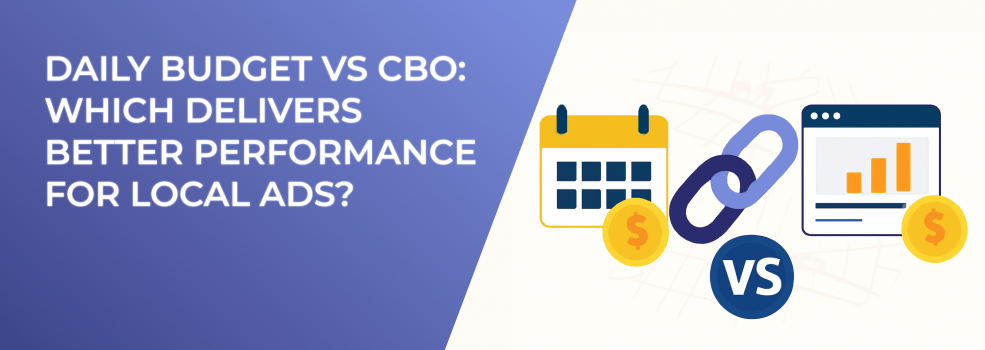Running local Facebook and Instagram ad campaigns is a lot like marketing your business in a busy farmers’ market. You’ve got a small booth, a limited stack of flyers, and only a few hours to catch the right people’s attention. Every decision (especially how you allocate your ad spend) matters. One of the most critical, and often underestimated, choices you’ll make is between daily budgets and Campaign Budget Optimization (called Advantage Campaign Budget now).
These two budget strategies aren’t just technical settings. They directly shape your campaign's performance, learning potential, and overall return on investment. So, which one makes more sense for local businesses?
Let’s explore the pros, pitfalls, and ideal use cases of each, along with practical tips to help you choose the right fit.
What’s the real difference?
On the surface, the difference between Daily Budgets and CBO might seem like a minor toggle in your campaign setup. But fundamentally, they represent two very different approaches to managing how your money is spent.
-
Daily budget: you set a fixed daily spend for each ad set. This gives you direct control over how much is allocated to different audience segments, geographies, or ad objectives.
-
Campaign Budget Optimization (CBO): you set one campaign-wide budget, and Facebook’s algorithm automatically distributes that spend across your ad sets based on performance — in real time.
Why it matters: this distinction plays a major role in how much control you have, how fast you get results, and how much insight you gain about different segments of your audience.
Example: a local hair salon wants to promote its new location by targeting three zip codes nearby. With daily budgets, the salon can spend exactly $20/day per zip code to ensure each neighborhood gets equal exposure. With CBO, Facebook might funnel most of the budget into just one area based on early results, potentially overlooking the others.
Tip: if your goal is to test multiple segments or keep spend evenly distributed, Daily Budgets are the safer choice. But if you're confident in your audience and want Facebook to dynamically optimize for performance, CBO may be more efficient.
Ask yourself: do I want even exposure across all audiences? Or am I comfortable letting Facebook decide which audience gets the most spend?
Control vs. efficiency: what matters more?
Daily budgets prioritize control and balance. You get to dictate how much attention each ad set receives, which is particularly important when:
-
You're testing new audiences or creatives.
-
You want clean, comparable data from each segment.
-
You’re working with limited insights and need to understand what works.
This structure ensures no audience is left behind even if it performs slower than others.
Example: a real estate agent wants to compare ad performance between suburban families, downtown professionals, and out-of-town investors. With daily budgets, she can maintain even delivery to each group and make informed decisions based on consistent data.
CBO, on the other hand, is about efficiency and automation. It’s designed to help you get the most results from your overall budget without micromanaging ad sets. Facebook’s algorithm shifts spend automatically toward the highest-performing ad sets, sometimes within hours.
Example: a tutoring center targets parents, college students, and professionals. CBO identifies that parents are clicking and converting most early on and shifts the majority of the spend there. This reduces the cost per lead, but it also means the other segments get limited reach.
Tip: CBO is ideal when:
-
You already know which creatives and audiences work.
-
You're focused on short-term conversions.
-
You don’t have the bandwidth to monitor and adjust budgets manually.
Ask yourself: am I still exploring what works, or am I optimizing something that’s already proven?
The algorithm’s bias and what it means for local campaigns
CBO relies heavily on Facebook’s machine learning. While this can be powerful, it’s not without flaws, especially for smaller, local advertisers.
The algorithm often favors quick wins. It identifies which ad sets perform well in the early hours and shifts budget accordingly. But that can be problematic if:
-
Your audiences behave differently throughout the day.
-
Some segments take longer to respond.
-
Your campaign needs time to gather meaningful data.
Example: a local pizzeria runs a weekend campaign promoting a family meal deal. Early in the day, tourists engage with the ad. Facebook’s algorithm shifts the majority of the budget to tourists. But by evening, locals begin engaging — too late, as the budget has already been spent.
With daily budgets, each group would have received consistent exposure throughout the day, allowing for more balanced results.
Tip: if you’re running a campaign under $50/day with three or more ad sets, consider starting with daily budgets. This ensures you collect a fair amount of data from each segment before drawing conclusions.
Ask yourself: could early performance data distort the campaign’s direction? Does each segment need time to reach its full potential?
If you're using CBO and noticing that certain audiences aren't getting any traction, it may help to understand why some of your ad sets may get little or no results and what you can do about it.
When speed and scale matter
CBO isn’t always risky. In fact, there are several scenarios where it’s the better option, particularly when speed and scale are crucial.
Let’s say your campaign is highly time-sensitive — a 24-hour sale or weekend-only offer. You don’t have the luxury to monitor results and manually shift budgets. CBO’s real-time optimization can help you maximize conversions in a short window.
Example: a local boutique runs a flash sale with limited inventory. CBO quickly identifies that people aged 25–34 in a 5-mile radius are converting the most and redirects the bulk of the spend there, helping clear stock before the sale ends.
CBO also works well when scaling geographically. If you’re expanding from one neighborhood to multiple cities, CBO can help you quickly determine which markets are most responsive.
Tip: for CBO to be effective, set up your campaign with structure:
-
Use 2 to 5 ad sets with similar goals.
-
Avoid mixing awareness and conversion objectives in one campaign.
-
Let the campaign run for at least 3–5 days before making changes.
Watch out: don’t group drastically different audiences (like students and retirees) in one campaign. Facebook may over-prioritize one and ignore the rest, making performance uneven.
Ask yourself: is my campaign time-sensitive? Am I ready to scale quickly, or am I still refining my approach?
To get the most from your budget — whether using daily budgets or CBO — it's essential to choose the right Meta ad objective from the start. Misaligned objectives can limit optimization no matter which strategy you choose.
So... which one wins?
There isn’t a one-size-fits-all winner. The right choice depends on where your campaign stands and what you're trying to achieve.
Use daily budgets if:
-
You're testing new audiences or geographies.
-
You want clean data to compare ad set performance.
-
You have varied goals across ad sets, such as a mix of engagement and foot traffic.
Use CBO if:
-
You're scaling a campaign with proven creatives and audiences.
-
You need fast optimization during a short promotion or event.
-
You prefer automation over manual budget management.
Tip: many advertisers start with Daily Budgets to test and learn. Once the top-performing segments are clear, they transition to CBO for efficiency.
Ask yourself: is your current campaign in the learning phase or the growth phase? Would automation help you move faster, or do you still need more control?
Making the most of your budget strategy
Getting the best performance isn’t just about choosing Daily vs. CBO — it’s about using each method strategically.
Daily budget best practices:
-
Set a minimum of $10–$20 per ad set to exit the learning phase.
-
Avoid frequent budget changes, which can reset optimization.
-
Use automated rules to pause underperforming ad sets or cap spend.
CBO best practices:
-
Group ad sets by similar conversion intent or funnel stage.
-
Limit ad sets to 2–5 per campaign to avoid budget dilution.
-
Be patient — let CBO stabilize before evaluating or tweaking.
Example: a local fitness studio tests four nearby suburbs using daily budgets. After two weeks, they identify the two top-performing areas and launch a CBO campaign focused solely on those zip codes, driving sign-ups for a new class with minimal manual effort.\
If you're struggling to gather enough data with daily budgets, these tips can help you finish the Facebook learning phase faster without overspending.
Final thoughts
Your budget allocation strategy is more than a setting — it’s a key component of your overall marketing approach. For local businesses, where every dollar must pull its weight, the right budgeting method can drive better results, more efficient spending, and smarter insights.
Use daily budgets when you need control and clarity. Use CBO when you’re ready to move faster and scale smarter.
And above all, keep testing. Even the best strategies evolve.

